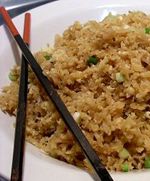The clamoring of pots, the shouts of orders, the steam of fragrant oils and spicy food leak onto the streets. It’s just another busy Saturday for Philadelphia’s Chinatown retaurants. Rice is the center of Asian culture and it’s central ingredient, once abundant and cheap, is now in shortage.
More than 50 Asian restaurants line the sidewalks between Vine and Race streets and 8th and 11th streets. Attracting more than thousands of visits per year, Philly’s Chinatown has become a popular destination spot for tourists and Philadelphia’s own residents. With rising fuel costs and import taxes, Philly may be hit with another blow, possibly resulting in a decrease of visits and thus a decrease in business profits for these small business owners. The New York Times reports the trade deficit edged up in January, and the amount of money being paid for imports is rising at a double-digit rate for the first time since the fall of 2006.

Small businesses like Chung May Food Market has already felt the economic blow. “I used to buy a bag of exotic rice, like jasmine, for about $15, but the price has more than doubled, even for flour,” says Chung May, the store’s owner. Flurrying to grocery stores and markets, shoppers are stocking up on bags of rice. The short-term demand has skyrocketed the prices despite the decrease in production.
Like many small grocers, Chung May Food Market has eliminated the middleman. Sitting and waiting by the docks and receiving the first-handed shipment from distributors has decreased the tax and miscellaneous fees on imported goods for May. “A lot of us [small business owners] have been waiting at the docks to get the first shipment so there’s no extra tax for us.”
Another backlash for many Asian business owners have been the recent recalls on items made in China. “Luckily we don’t sell any of the ones that have been recalled but I’ve noticed many customers, including a lot of Asians who normally don’t read the labels on the back, reading and checking the labels,” says May. The pressure continues to grow for Asian store owners with a stressed economic relationship with China.
With increases on fuel and fertilizer prices, NPR has reported the cost of rice intensified up to 30%. Heavily dependent on imported goods, small owners in Chinatown are having a difficult time meeting the well-known cheap prices Asian markets are infamous for. “A majority of the items in my store are about 50% from China and the rest from other Asian countries like Taiwan and Japan,” says Anthony Lew of New World Laundromat and Food Market.

Tucked among a long line of stores and restaurants, the unassuming storefront can be easily overlooked by visitors and travelers. A small market with an entire backroom filled with several washers and dryers, customers are mainly local consumers. Purchasing snacks and other miscellaneous grocery items while waiting for the spinning cycles to finish, Lew has noticed a gradual slow in traffic to the market.
Seeping into the restaurant business, the pressure of the rice economy has also steamed restaurateurs. The rising import taxes on flour alone have set back many restaurants, leading to an increase on meal prices. “The regular food price increased by a lot, some by 100%. That really hurt the restaurant business. A lot of the restaurants are going to adjust the menu price,” says Michael Chow, Executive Chef and Owner of Sang Kee Peking Duck, Sang Kee Asian Bistro, Peking Noodle House, and Sang Kee at the Reading Terminal Market. Much of Sang Kee’s menus specialize in noodles served with over 200 listed choices to eat with the noodles. Without rice, many Asian restaurants would be in abyss. Dishes are served along with a bowl of rice or noodles to complement the salty, sweet, and spicy flavors of the East. Diners, who are accustomed to the reasonable prices that many Asian restaurants offer, are sure to notice the difference.
The struggle to keep prices low in Chinatown will be at test, more so now than ever before. Competition is steep and the hunger for rice isn’t about to decline. Will Chinatown be able to keep up with the community’s demands to preserve the soul of this neighborhood?
Subscribe now to our national urban issues magazine! Click here for more details! Or, check out our events calendar and find out how you can get involved with the revitalization of your city!






_600_350_80_s_c1.jpg)









